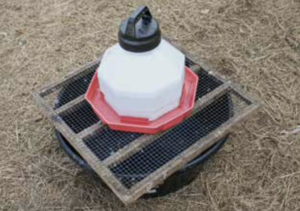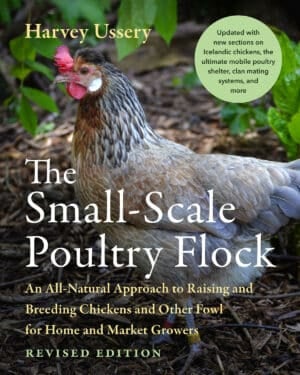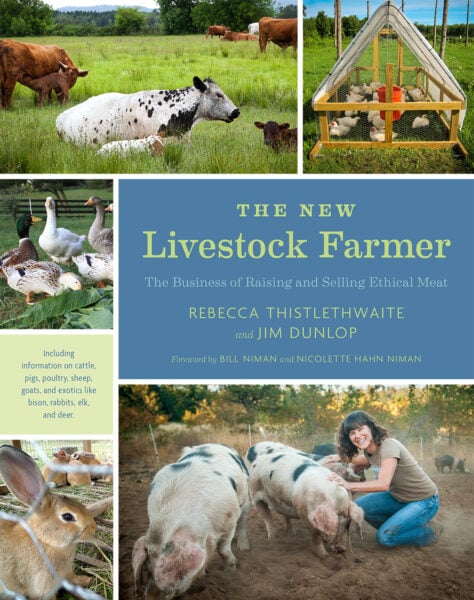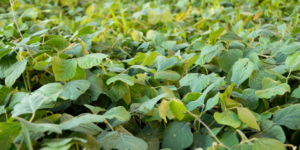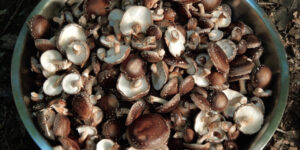Managing Chicken Manure: The Joys of Deep Litter
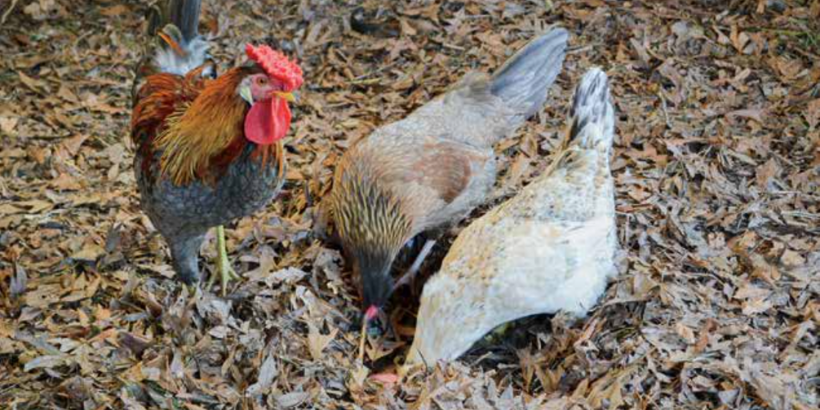
Ever heard the phrase, “always follow your nose?” As it turns out, this is a good rule of thumb when it comes to chicken manure. Composting chicken manure in deep litter helps build better chicken health, reduce labor, and retain most of the nutrients for your garden.
The following is an excerpt from The Small-Scale Poultry Flock, Revised Edition by Harvey Ussery. It has been adapted for the web.
Unless otherwise noted, all photographs copyright © 2022 by Harvey Ussery.
Materials for Deep Litter
The poops laid down by the birds are rich in nitrogen, so naturally—as in the compost heap—we want plenty of carbonaceous material in the litter to balance it.
In contrast to the ideal C:N ratio for a compost heap, however, the higher the carbon content of the deep litter, the better. That is, the more carbon in the mix, the more nitrogen- rich manure the litter can absorb before the C:N ratio shifts out of balance, resulting in production of ammonia.
Which Material for Deep Litter Should You Choose?
The high-carbon material chosen for the deep litter depends on what is cheapest and most readily available to you. It should ideally be somewhat coarse, so the scratching of the chickens fluffs it up and incorporates plenty of oxygen, assisting its breakdown by microbes and discouraging growth of pathogens.
I prefer oak leaves, but that’s mostly because a close neighbor, who has half a dozen mature white oaks on her place, prefers to get rid of the accumulating leaves in the fall. She even hauls them over and dumps them in a big pile at my place. I say “God bless ’er!”
Using Wood Shavings and Woodchps
Kiln-dried wood shavings are excellent, with their extremely high carbon-to-nitrogen ratio (500:1), but are an additional expense if you must purchase them. For example, I recently bought compressed shavings at $6 per bale (expands to 8 cubic feet [.2 cubic m]) to use as brooder bedding. Buying enough to deep- bed the entire henhouse would be expensive indeed.
Wood chips might serve—they too are extremely high in carbon and last a long time before they need to be replaced. Joel Salatin uses them as the litter in his Raken House—he cleans out only once a year, when even this coarse woody material has been reduced to compost by the microbes and the constant working of the chickens.
Sawdust is satisfactory, though it doesn’t fluff up as much as other materials. Whether using sawdust, wood shavings, or wood chips, be sure to use either kiln-dried or aged material—“green” woody materials may sup- port the growth of molds, whose spores could be bad for your birds’ respiratory systems and yours.
Materials to Avoid: What NOT to Use for Deep Litter
Note that old hay and certain crop residues such as soybean vines are not appropriate as litter materials — with a significant nitrogen content of their own, they do not effectively balance the nitrogen in the poultry droppings and quickly heat up.
Using Straw for Deep Litter
What about straw? Many flocksters avoid the use of straw because, especially in the presence of the slight dampness of an earth floor, it can support the growth of Aspergillus molds, whose spores can cause serious respiratory problems. I have corresponded with flocksters, however, who report they use straw over an earth floor without problems.
I have never used a litter of exclusively straw over an earth floor, though I have used it in a mix with a much higher proportion of oak leaves— with no mold problems. Note that there is no problem using straw as the litter over a wooden floor—the drier conditions in such a litter prevent growth of Aspergillus.
Other Potential Litter Materials
Nearby processing of agricultural crops may furnish other litter materials. Milling of corn, cane, buckwheat, or peanuts, for example, may generate corncobs, chopped corn or cane stalks, or hulls that are available cheaply enough to be used as deep litter.
Alchemy
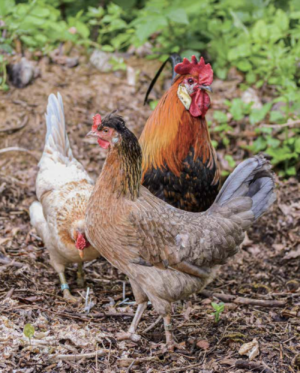 Over many years showing visitors through my poultry house, I have noticed that if my visitor has previously been in a chicken house, at some point she will sniff the air with a puzzled look and ask, “Why doesn’t it stink in here?” When that happens, I know I’m on the right track with manure management.
Over many years showing visitors through my poultry house, I have noticed that if my visitor has previously been in a chicken house, at some point she will sniff the air with a puzzled look and ask, “Why doesn’t it stink in here?” When that happens, I know I’m on the right track with manure management.
Improving Chicken Health With Deep Litter
But the transformation of “nasty” to “nice” is just part of the magic. Remember the comparison of the deep litter to an active compost heap—the process in deep litter is driven by the same happy gang of microbes. And among the metabolites of the microbes—by- products of their life processes—are vitamins K and B12, in addition to other immune-enhancing compounds.
The chickens ingest these beneficial substances as they find interesting things to eat in the litter. Don’t ask me what they’re eating, but chickens on a mature deep litter do little other than scratch and peck. This is alchemy indeed: What started as repugnant and a potential vector for disease has been transformed into a substrate for health.
More Benefits of Deep Litter
Should you think I’m spinning fairy tales, know that scientific experiments have borne out the benefits of a bioactive deep litter. I urge you to read the full research bulletin from the Ohio Agricultural Experiment Station mentioned in chapter 6, but to summarize a point that is especially relevant here: One experiment compared two groups of growing pullets, both on old built-up deep litter but one group receiving a complete ration, the other fed a severely deficient diet. Mortality and weight gain in the two groups were virtually identical.
In another experiment comparing pullets fed a severely deficient diet, groups on old, thoroughly bioactive litter suffered far lower mortality (7 percent as opposed to 23 percent) and achieved much higher weight gain (at 12 weeks, 2.34 compared to 1.64 pounds [1 to .7 kg]) than those on fresh litter. Both these and other experiments demonstrated: “Obviously, the old built-up litter adequately supplemented the incomplete ration.”1
Deep Litter Management
Plan for the use of deep litter when designing housing for your flock—deeper litter absorbs more manure and supports more microbes, so allow plenty of space for it. Aim for a depth of 12 inches (30 cm) if possible. Happily, in winter you can factor in as well the role of that thick layer of organic duff in insulating the coop from the frozen ground outside—and the heat generated in an active deep litter.
Temperature Considerations
The temperature is nothing like that of a well-constructed compost heap; but the warmth rising out of the pack moderates air temperature in the winter house. Caroline Cooper of British Columbia, Canada, sees temperatures of −13°F (−25°C) for two weeks at a stretch in a typical winter but finds that the bedding in her hoophouse, 12 to 18 inches (30 to 45 cm) deep, is warm to the touch a few inches below the surface.
The great thing about deep litter is that the birds do most of the work. But there are a few things requiring input and monitoring on your part as well.
Stocking Density
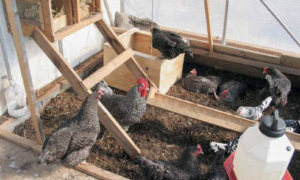
Each pen is furnished with laying nests, dustbox, waterer (sometimes kept outside), hanging feeder, and deep litter.
Joel Salatin makes this observation about stocking density on a deep litter: If you allow 5 square feet (.5 square m) per adult chicken, the birds’ constant scratching will incorporate into the litter all the manure laid down, even in high-poop areas such as those under the roosts.
At 4 square feet (.4 square m), there will be some capping of manure under the roosts—formation of a crusty layer impervious to the hens’ scratching. At 3 square feet (.3 square m), there will be extensive cap-ping. If there is capping of the manure in your coop, turn it over with a spading fork from time to time, and the chickens will break it up from the cap’s underside.2
Let It Mellow
You will see advice that the coop should periodically be thoroughly cleaned out. But as the Ohio Agricultural Experiment Station experiments demonstrated, it is not fresh new litter that supports the health of the flock but “old built-up”—that is, highly biologically active—litter. Thus this important implication: Never clean out the litter completely.
Once beneficial levels of microbial activity are established, don’t get rid of them by a de rigueur “thorough clean-out.” Over time, the buildup of the litter—or the need for compost for the garden—requires removing part of the litter. Leave plenty in place, however, to retain the benefits of the already active microbes and to “inoculate” the fresh material you add.
The Whiff Test
The caveat to the “mellow” rule against cleaning out too much of the litter is that inevitably the addition of nitrogen by the incoming poops will overwhelm the carbon in the mix—resulting in the generation of ammonia.
Be alert to that first characteristic whiff: It is telling you that an imbalance must be corrected— both because nitrogen for soil fertility is being lost to the atmosphere, and because ammonia damages the chickens’ delicate respiratory tissues. Reestablishing the necessary balance is simply a matter of generously top- ping off with your high-carbon litter material of choice.
Do note that ammonia’s deleterious effects begin below the concentration our nose can detect (25 to 30 parts per million). With experience, you will learn to “read” the developing condition of the litter, so you can add fresh carbonaceous material before it starts generating ammonia.
Avoid Wet Litter
If you provide water inside, avoid wet litter. A soaked litter is anaerobic—deprived of oxygen—and more likely to support growth of pathogens. Wet litter also generates ammonia far more readily than drier litter.
Generous airflow through the coop prevents litter dampness. Wet litter is more likely around the waterer, so check conditions there often; scatter any wet litter out over the total litter surface, where the chickens’ scratching will help dry it. Waterfowl are especially likely to wet the litter.
However, the busy critters in the litter need water for their work—monitor the litter to ensure that it is not powder-dry. Caroline Cooper reports that the winter air in British Columbia is extremely dry, so from time to time she carefully adds water to the litter to keep it active. If I have a waterer inside the chicken house, I frequently empty the small amount of water in its trough directly into the litter when rinsing it out.
Using the Compost
The deep-litter approach to manure enlists the flock in the great work of soil fertility. Over time—up to a year—the litter will be reduced by the action of chicken and microbe to a finished compost. When it’s time to “harvest” the compost, fork aside the top, coarser material that “floats” over the finely granulated, slightly moist material below. That’s the good stuff.
Sniff a handful: Like any fine compost, it will smell of earth with not the slightest hint of raw manure. In my experience litter at this stage of decomposition is ready to use directly in the garden—it will not burn plants, will not inhibit seed germination, and visibly boosts the growth of crops.
In my experience, litter from a coop with a wooden floor is too raw to apply directly in the garden. Such litter should be further broken down in a conventional compost heap before use in the garden.
Notes
1. Kennard and Chamberlin, “Built-Up Floor Litter.”
2. Joel Salatin discusses a “loose housing option” for a layer flock in Pastured Poultry Profit$ (Polyface, Inc., 1993), 259–61, in which he recommends a “target minimum space allotment” of 5 square feet (.5 square m) per hen. His observations about stocking density in a flock on deep litter in relation to capping are from several of his presentations I have attended.
Recommended Reads
Un-Coop Your Poop: Everything You Need to Know About Chicken Tractors
Recent Articles
Want to see your crops thrive this upcoming growing season? The key is in soil fertility and health. Spend time maintaining your soil’s health to guarantee bigger and better crops come harvest time! The following is an excerpt from No-Till Intensive Vegetable Culture by Bryan O’Hara. It has been adapted for the web. What Is Soil Fertility?…
Read MoreMany know the effects of catnip on our feline friends, but few realize that catnip has medicinal effects for humans. From stomach aches to reducing fevers, catnip is a versatile herb with many benefits. The next time you grow this plant for your cat you may end up taking a few cuttings for yourself! The…
Read MoreIt’s time to take control of your seeds and become a plant breeder! Saving your seed allows you to grow and best traditional & regional varieties, and develop more of your own. The following excerpt is from Breed Your Own Vegetable Varieties by Carol Deppe. It has been adapted for the web. Becoming A Plant…
Read MoreTrying to figure out how to manage weeds in your garden beds? Use cover crops and living mulches for weed suppression while your garden flourishes! The following is an excerpt from The Ecological Farm by Helen Atthowe. It has been adapted for the web. Suppressing Weeds With Cover Crops: Getting Started Cover crops suppress weeds…
Read MoreInterested in becoming a mushroom farmer? Shiitake mushrooms are one of the easiest and most profitable places to start. The following is an excerpt from Farming the Woods by Steve Gabriel and Ken Mudge. It has been adapted for the web. (Photographs courtesy of Steve Gabriel and Ken Mudge unless otherwise noted.) The Stunning Shiitake…
Read More

